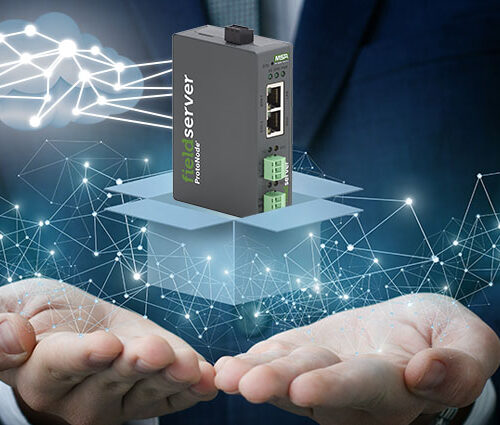
Author: Jim Ralston – Business Development Manager, FieldServer
As data centers expand to support AI, cloud platforms, and enterprise-level workloads, their IT teams are also expanding their support by tightening control over everything that connects to the network, including OEM devices. Because every device that requests an IP address, opens a port, or transmits data is now part of secure infrastructure, OEMs and their customers can’t afford to risk taking a “set and forget” approach.
Whether it’s a chiller, power meter, backup power generator, fuel monitor, or environmental sensor, every connected device must comply with IT security policies, support secure communication, and pass rigorous approval processes. Without the ability to securely and seamlessly integrate into data center operations, OEM devices may not make it past specification review, let alone into the operation.
This article shares practical insights from the field, as well as technical strategies to help OEMs deliver protocol-ready, security-aligned devices that fit naturally into data center environments, without raising red flags or requiring IT exceptions.
Data Center Device Approval: What IT Teams Want OEMs to Know
Not that long ago, Operational Technology (OT) teams managed connected devices without much, if any, assistance from IT. If the device functioned, it was approved and installed. Now, however, things have changed. OT and IT (Information Technology) work in tandem to ensure both the functionality and security of connected devices.
That means OEM equipment is expected to:
- Support IP assignment via DHCP or static configuration based on site policy
- Operate on segmented subnets or VLANs to reduce exposure
- Restrict open ports and services to minimize attack surfaces
- Offer remote diagnostics only if explicitly approved
- Avoid general-purpose operating systems that require patch cycles
The challenge? Most OEMs weren’t designing for this high level of scrutiny even just a few years ago. Those that still don’t account for it are risking slow approvals, security pushback, and even opportunity. Those that do, however, move faster and stand out as reliable, IT-ready partners, all while earning trust across the enterprise.
Build vs. Buy: Options for OEM Devices
Every OEM engineering team faces the same dilemma when developing new products or updating existing ones: spend months coding communication protocols from scratch or integrate a proven gateway solution that’s ready to go.
It’s not an easy choice, and the wrong decision can cost time, money, and market opportunities. Here’s a straightforward comparison of the three main options:
Build In-House
- Pros: Fully customizable design with no licensing fees
- Cons: Extended development timelines (6-18 months), expensive certification processes, ongoing security patches and maintenance, dedicated engineering resources required
Buy a Controller with Built-in Protocol Support
- Pros: Readily available from suppliers, proven reliability, vendor support included
- Trade-offs: Higher per-unit costs, limited customization options, potential supply chain constraints, vendor lock-in
Integrate a FieldServer Gateway Solution
- Pros: Rapid deployment (weeks vs. months), extensive protocol library, IT-friendly architecture, predictable costs, ongoing support
- Considerations: Requires brief initial evaluation period, involves partnership with proven gateway specialist
FieldServer gateways are a compact, protocol-ready solution that helps OEMs bridge the gap between custom development and off-the-shelf controllers. Our solution installs as a hardware component yet functions as a software-defined gateway, eliminating the need for internal protocol development or certification.
Additionally, FieldServer gateways enable complete customization of device profiles, part numbers, and factory configurations, allowing OEMs to maintain their unique product identity while leveraging proven communication protocols.
The Bottom Line: Unlike the other approaches, FieldServer protocol gateways enable an accelerated time-to-market while maintaining the flexibility needed for product differentiation.
Win the Project: 6 Ways FieldServer Helps OEMs Meet Data Center Requirements
Data center IT teams are more likely to reject OEM devices if they have the potential to create security risks, add complexity, or require ongoing maintenance.
Here are 6 ways FieldServer gateways can help OEMs transform their equipment into an IT-friendly solution that is more likely to pass security reviews and accelerate the purchase cycle.
1. Pass Security Reviews Faster
The FieldServer’s hardened firmware platform eliminates the common IT objections that kill a project before it’s approved. Because FieldServer gateways have no operating system vulnerabilities, no patch management requirements, and no shell access concerns, OEM devices are more likely to get through the all-important security review faster.
2. Simplify Network Integration
The FieldServer’s dual Ethernet ports let IT teams isolate field networks from enterprise systems without complex VLAN configurations or security workarounds. This means OEM devices can integrate cleanly into existing network architectures without requiring infrastructure changes.
3. Support Any IP Policy
Whether the data center uses static IPs or DHCP, FieldServer devices adapt without firmware changes. Ship one SKU that works in any environment and reduce inventory complexity while meeting diverse site requirements.
4. Meet Zero-Trust Requirements
With FieldServer gateways, only essential ports are enabled by default. This minimal attack surface design aligns with modern security frameworks and reduces the IT team’s risk assessment workload.
5. Offer Flexible Remote Access
The FieldServer Manager, MSA’s own Software-as-a-Service (SaaS) cloud-based solution, can be disabled for air-gapped environments or configured with granular access controls for secure remote diagnostics. That means IT teams can get the connectivity model that aligns with their security policies and procedures.
6. Provide Audit-Ready Documentation
MSA’s third-party security assessments and ISO/IEC 27001 aligned development processes for its FieldServer platform give IT teams the compliance documentation they need to justify purchases to senior management and security auditors.
The Result: FieldServer-enabled OEM devices become the low-risk, easy-to-deploy choice.
5 Ways OEMs Can Better Navigate Data Center Compliance Requirements
Here’s are proven strategies OEMs can take right now to improve their chances of winning IT approval and the bid:
1. Create Network Integration Documentation
Map how the equipment will connect to the data center’s infrastructure. Show field device connections separate from enterprise network access. This documentation becomes a lifeline during IT security reviews, helping OEMs prove their solution won’t create network headaches or security gaps.
2. Define Your Protocol Strategy
List which industrial protocols the equipment supports and how data flows to building management systems, DCIM platforms, or cloud services. IT teams need to understand what’s talking to what and how it all fits together.
3. Document Network Security Posture
Provide a clear inventory of network ports, communication requirements, and security controls. Think of this as the equipment’s “network passport,” featuring what it needs to access and why.
4. Clarify Remote Management Options
Explain how the device’s remote access can be configured or toggled off to match security policies.
5. Prepare Compliance Documentation
Gather security assessments, vulnerability disclosures, and development certifications to give IT teams the proof they need to say “yes” to the equipment.
Final Thoughts
FieldServer protocol gateways can help OEMs meet the challenge with out-of-the-box tools, including dual Ethernet ports, configurable IP behavior, no open OS, controlled remote access, and validated security processes.
Remember: When OEMs design with compliance in mind, products get approved faster, integrate more easily, and meet specifications. Contact us to learn more.






